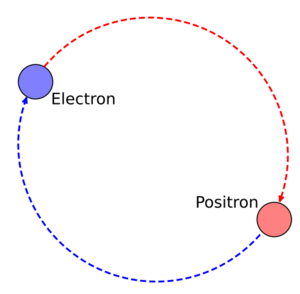Positronium facts for kids

Positronium is a unique and very interesting type of "exotic atom." It's different from regular atoms because it's not made of protons, neutrons, and electrons. Instead, positronium is formed when a tiny particle called an electron meets its antimatter twin, a positron. These two particles orbit around each other for a very short time before they disappear in a flash of energy.
Contents
What is Positronium?
Positronium is like a mini solar system, but instead of a sun and planets, it has two tiny particles spinning around each other. One particle is an electron, which has a negative electric charge. The other is a positron, which is exactly like an electron but has a positive electric charge. The positron is also known as an "antielectron" because it's the antimatter version of an electron.
How is Positronium Formed?
Positronium forms when an electron and a positron come close enough to each other. Because they have opposite charges (negative and positive), they are attracted to each other. This attraction makes them orbit around a common center, creating the positronium atom. It's a very unstable atom, meaning it doesn't last long at all.
How Long Does Positronium Last?
Positronium has an incredibly short lifespan. It usually lasts for much less than one second, often just a tiny fraction of a second. After this brief moment, the electron and the positron meet and destroy each other in a process called "annihilation."
What Happens When Positronium Annihilates?
When the electron and positron annihilate, their mass is completely converted into energy. This energy is released in the form of high-energy light particles called gamma rays. Usually, two gamma rays are produced, shooting off in opposite directions. Scientists study these gamma rays to learn more about the particles and the universe.
Why Do Scientists Study Positronium?
Scientists are very interested in positronium because it helps them understand the basic rules of physics, especially a theory called quantum electrodynamics (QED). QED describes how light and matter interact. Since positronium is a simple system of just two particles, it's a perfect "laboratory" for testing these fundamental theories with great accuracy.
Uses of Positronium Research
Studying positronium can lead to new discoveries in many areas. For example, it helps us understand antimatter, which is a mysterious part of our universe. It also has potential uses in fields like medicine, such as in medical imaging techniques like PET scans, which use positrons to create detailed images of the inside of the body.
Images for kids
-
The Positronium Beam at University College London, a lab used to study the properties of positronium.
See also
 In Spanish: Positronio para niños
In Spanish: Positronio para niños


